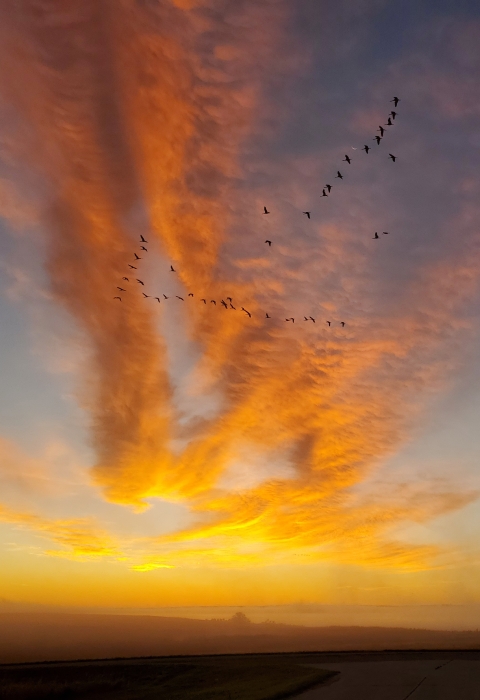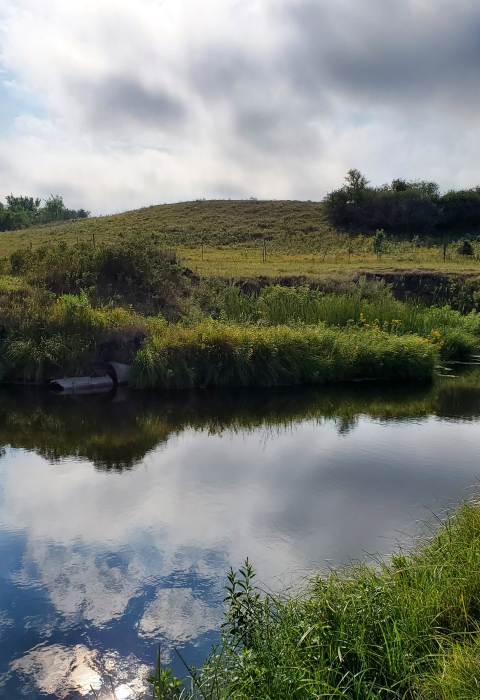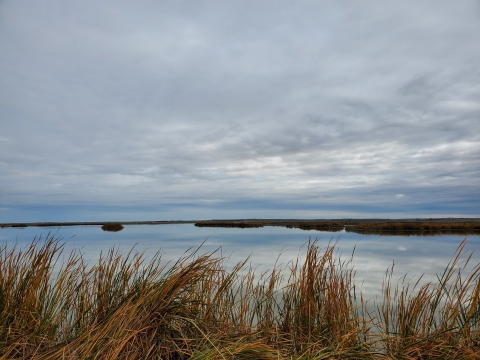What We Do
Wildlife conservation is at the heart of the National Wildlife Refuge System. It drives everything on U.S. Fish and Wildlife Service lands and waters managed within the Refuge System, from the purposes for which a national wildlife refuge national wildlife refuge
A national wildlife refuge is typically a contiguous area of land and water managed by the U.S. Fish and Wildlife Service for the conservation and, where appropriate, restoration of fish, wildlife and plant resources and their habitats for the benefit of present and future generations of Americans.
Learn more about national wildlife refuge is established to the recreational activities offered to the resource management tools used. Using conservation best practices, the Refuge System manages Service lands and waters to help ensure the survival of native wildlife species.
The staff at Long Lake National Wildlife Refuge work to provide the life requirements of waterfowl, other migratory birds, and resident wildlife. Recreational opportunities that are compatible with the Refuge are also offered for visitors.
Refuge staff strive to maintain the habitat, consisting mostly of mixed-grass prairie, through management techniques such as livestock grazing, prescribed burning, haying, weed control, water level management, and rest. Livestock grazing is used in spring and early summer to stress exotic cool-season grasses such as Kentucky bluegrass and brome grass. In return, native grasses and forbs are favored and hopefully out-compete exotic grasses in the future. Prairies generally need frequent, carefully timed, defoliation. One defoliation method used is prescribed fire. Prescribed burning is usually conducted on areas where grazing isn’t available or there are newly established native grass seedings.
A primary resource goal of the Refuge is to prevent, or at least manage, avian botulism. Avian botulism is caused by naturally occurring bacteria that produces a toxin found in invertebrates. The disease paralyzes and often kills birds, especially waterfowl and shorebirds. Three dikes provide the means to control water levels and reduce botulism outbreaks in Long Lake.
Refuge staff also use trapping as a wildlife management tool. Trapping may be used to protect endangered and threatened species, migratory birds, or to control certain wildlife populations. The U.S. Fish and Wildlife Service views trapping as a legitimate recreational and economic activity when there are harvestable surpluses of fur-bearing mammals.
Management and Conservation
Refuges deploy a host of scientifically sound management tools to address biological challenges. At this field station, our conservation toolbox includes:
- Planning – Comprehensive Conservation Plan: The purpose of a comprehensive conservation plan is to specify a management direction for the Refuge for the next 15 years. The goals, objectives, and strategies for improving Refuge conditions—including the types of habitat we will provide, partnership opportunities, and management actions needed to achieve desired conditions – are described in the comprehensive conservation plan. The Service’s preferred alternative for managing the Refuge and its effects on the human environment, are described in the comprehensive conservation plan as well. The Long Lake National Wildlife Refuge Complex Comprehensive Conservation Plan was approved in 2006 and is scheduled for review and revision in 2021.
- Habitat Restoration: A wide array of exotic species management practices, including biological agents, mechanical control, grazing treatments, and chemical application, are used to restore native vegetation and control exotic species on the Refuge.
- Agriculture: Grasslands with past farming history can be restored to native species through farming and re-seeding practices.
- Climate Resilience: A weather station on the Refuge provides a current and historical record of weather conditions.
- Conservation Easements: The wetland management district wetland management district
A wetland management district is a U.S. Fish and Wildlife Service office that manages waterfowl production areas in one or more counties. Waterfowl production areas are small natural wetlands and grasslands that provide breeding, resting and nesting habitat for waterfowl, shorebirds, grassland birds and other wildlife. The Fish and Wildlife Service acquires waterfowl production areas under the authority of the Migratory Bird Hunting and Conservation Stamp Act, primarily using funds from the sale of Federal Duck Stamps. The Refuge System’s 38 wetland management districts comprise thousands of waterfowl production areas – almost all in the Prairie Pothole Region of the Northern Great Plains.
Learn more about wetland management district conserves easement refuges as well as private land easements. - Education and Outreach: Kiosks and brochures are found in the front entrance of the Long Lake National Wildlife Refuge office. Outreach is facilitated through school groups, day care centers, 4-H clubs and other organizations that come to the Refuge to learn about the natural environment.
- Fire Management: Fire releases nutrients to enrich the soil, reduces invasive plants, encourages native species, and creates habitats that are attractive to wildlife. Grasslands are burned primarily to alter vegetation and increase biological productivity and diversity or to accomplish other specific goals.
- Grazing: Grazing is conducted through a permit process with neighboring ranchers. Grazing allows for habitat management objectives to be met while providing rest on private pastureland.
- Compatibility Determinations: Used in the process of permits.
- Invasive Species: Haying/weed control is usually done on newly established grass seedings or weed infested areas. A permit is issued to a local farmer/rancher that allows clipping and baling of grass, usually after August 1st. This conserves Refuge resources by not having to haul equipment and clip the infestations. In return, the farmer/rancher’s cattle utilize the grass during the long winter months.
- Inventory and Monitoring: Conducted by surveys related to duck pair counts and Native Prairie Adaptive Management.
- Land Acquisition: In the wetland management district, private lands are acquired by enrollment in the easement program.
- Law Enforcement: Law enforcement is an integral part of managing the National Wildlife Refuge System. Refuge law enforcement officers are responsible for upholding federal laws and regulations that protect natural resources, the public, and employees.
- Pesticide Management
- Recreation Management
- Species Research
- Water Management
- Wildlife Health
Our Services
At this field station we offer the following services:
- Cooperative Agriculture - Partnerships with the Refuge System bring innovative approaches to solving land management issues in the most protective manner. Scientifically informed and technologically based stewardship of our public lands, water, wildlife and special places must be a collaborative effort between the Refuge System, private landowners and organizations, and other government agencies if conservation efforts are to succeed.
- Habitat Planning & Management
- Special Use Permits
- Recreation - We have several forms of recreation available at the Refuge. Please visit our Visit Us page to learn more about facilities and amenities for visitors.
Law Enforcement
Law enforcement is an integral part of managing the National Wildlife Refuge System. Refuge law enforcement officers are responsible for upholding Federal laws and regulations that protect natural resources, the public, and employees. They also strive to assist visitors in understanding Refuge laws, regulations, and the reasons for them.
Laws and Regulations
The National Wildlife Refuge System, the only system of Federal lands devoted specifically to wildlife, is a network of diverse and strategically located habitats. More than 565 national wildlife refuges and thousands of waterfowl production areas across the United States teem with millions of migratory birds. They serve as havens for hundreds of endangered species, and host an enormous variety of other plants and animals. Over 39 million people visit units of the National Wildlife Refuge System each year to enjoy a wide range of wildlife related recreational opportunities. To maintain this system, the passage and creation of laws and regulations, such as the National Wildlife Refuge System Improvement Act, ensures a strong and singular wildlife conservation mission.


